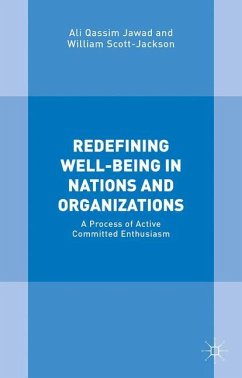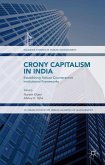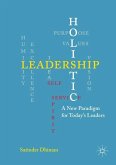Ali Qassim Jawad Al Lawati, William Scott-Jackson, Ali Qassim Jawad
Redefining Well-Being in Nations and Organizations
A Process of Improvement
Ali Qassim Jawad Al Lawati, William Scott-Jackson, Ali Qassim Jawad
Redefining Well-Being in Nations and Organizations
A Process of Improvement
- Gebundenes Buch
- Merkliste
- Auf die Merkliste
- Bewerten Bewerten
- Teilen
- Produkt teilen
- Produkterinnerung
- Produkterinnerung
Redefining Well-Being in Nations and Organizations is an essential book for researchers, policy makers and managers. It provides a new multi-disciplinary perspective on wellbeing and engagement, reviewing the latest research from several previously unrelated disciplines to develop a process for active committed enthusiasm (PACE).
Andere Kunden interessierten sich auch für
![Crony Capitalism in India Crony Capitalism in India]() Crony Capitalism in India77,99 €
Crony Capitalism in India77,99 €![Impact of International Business Impact of International Business]() Impact of International Business77,99 €
Impact of International Business77,99 €![Moral Reasoning at Work Moral Reasoning at Work]() Øyvind KvalnesMoral Reasoning at Work22,99 €
Øyvind KvalnesMoral Reasoning at Work22,99 €![Corporate Fraud and Corruption Corporate Fraud and Corruption]() M. Krambia-KapardisCorporate Fraud and Corruption108,99 €
M. Krambia-KapardisCorporate Fraud and Corruption108,99 €![Corporate Fraud and Corruption Corporate Fraud and Corruption]() M. Krambia-KapardisCorporate Fraud and Corruption77,99 €
M. Krambia-KapardisCorporate Fraud and Corruption77,99 €![Holistic Leadership Holistic Leadership]() Satinder DhimanHolistic Leadership100,99 €
Satinder DhimanHolistic Leadership100,99 €![Telling Fairy Tales in the Boardroom Telling Fairy Tales in the Boardroom]() Manfred F.R. Kets de VriesTelling Fairy Tales in the Boardroom39,99 €
Manfred F.R. Kets de VriesTelling Fairy Tales in the Boardroom39,99 €-
-
-
Redefining Well-Being in Nations and Organizations is an essential book for researchers, policy makers and managers. It provides a new multi-disciplinary perspective on wellbeing and engagement, reviewing the latest research from several previously unrelated disciplines to develop a process for active committed enthusiasm (PACE).
Produktdetails
- Produktdetails
- Verlag: Palgrave Macmillan / Palgrave Macmillan UK / Springer Palgrave Macmillan
- Artikelnr. des Verlages: 978-1-137-57244-8
- 1st ed. 2016
- Seitenzahl: 244
- Erscheinungstermin: 3. Februar 2016
- Englisch
- Abmessung: 222mm x 145mm x 18mm
- Gewicht: 435g
- ISBN-13: 9781137572448
- ISBN-10: 1137572442
- Artikelnr.: 43853255
- Herstellerkennzeichnung Die Herstellerinformationen sind derzeit nicht verfügbar.
- Verlag: Palgrave Macmillan / Palgrave Macmillan UK / Springer Palgrave Macmillan
- Artikelnr. des Verlages: 978-1-137-57244-8
- 1st ed. 2016
- Seitenzahl: 244
- Erscheinungstermin: 3. Februar 2016
- Englisch
- Abmessung: 222mm x 145mm x 18mm
- Gewicht: 435g
- ISBN-13: 9781137572448
- ISBN-10: 1137572442
- Artikelnr.: 43853255
- Herstellerkennzeichnung Die Herstellerinformationen sind derzeit nicht verfügbar.
Dr. Ali Qassim Jawad Al Lawati has led numerous major public sector transformation and capacity development projects across the GCC, and is currently Senior Advisor at the Diwan of Royal Court, Sultanate of Oman. Ali has carried out major research in this field, including "Leading Smart Transformation: A Roadmap for a World Class Government" William Scott-Jackson is Chairman of Oxford Strategic Consulting and Visiting Professor at Cass Business School, UK, advising governments and companies on the strategic development of human capital and the effective management, development and utilization of people. He is a well-known author, researcher and presenter of new ideas and perspectives on key issues.
Contents
1. Redefining Wellbeing and Engagement: Why Bother?
1.1. Introduction
1.2. Why is it important
1.3. Integrating Wellbeing and Engagement
1.4. Scope of the Book
1.5. The Objectives of the Book
1.6. How is it organized?
2. Wellbeing. What is it?
2.1. Objective Wellbeing
2.2. Subjective Well-being
2.3. Wellbeing is Part of a Process with Causes and Outcomes
2.4. Wellbeing as the Absence of Disorder
2.5. Positive Psychology Perspective
2.6. Comparability and Equity in Subjective Wellbeing
2.7. Antecedents and Causes of Well-being
2.8. Homeostasis
2.9. Measuring Wellbeing
3. Engagement. What is it?
3.1. Is Engagement the Same as Job Satisfaction, Organizational Commitment, Job Involvement or Organizational Citizenship?
3.2. Models of Engagement:
3.3. Antecedents and Causes of Engagement
3.4. Positive Psychology and Engagement
3.5. Measuring Engagement
3.6. Outcomes of Engagement
3.7. Improving Engagement: Organizational Approaches
4. PACE: The Process of Active Committed Enthusiasm
4.1. PACE: What is it?
4.2. PACE: Measurement and Analysis
4.3. Applying PACE
5. Case Study: The Sultanate of Oman
5.1. Ongoing Engagement to drive Citizen Wellbeing in the Sultanate of Oman
5.2. The First Phase - Delivery of Basic Provisions (1970 - 1990)
5.3. The Second Phase - Economic Growth and Diversification (1991 - 2010)
5.4. The ThirdPhase - Intensive Engagement to Address Social Issues (2010 onwards)
6. Conclusions and Recommendations
6.2. Approaches to Measurement
6.3. Communications and Expectations
6.4. In Conclusion
1. Redefining Wellbeing and Engagement: Why Bother?
1.1. Introduction
1.2. Why is it important
1.3. Integrating Wellbeing and Engagement
1.4. Scope of the Book
1.5. The Objectives of the Book
1.6. How is it organized?
2. Wellbeing. What is it?
2.1. Objective Wellbeing
2.2. Subjective Well-being
2.3. Wellbeing is Part of a Process with Causes and Outcomes
2.4. Wellbeing as the Absence of Disorder
2.5. Positive Psychology Perspective
2.6. Comparability and Equity in Subjective Wellbeing
2.7. Antecedents and Causes of Well-being
2.8. Homeostasis
2.9. Measuring Wellbeing
3. Engagement. What is it?
3.1. Is Engagement the Same as Job Satisfaction, Organizational Commitment, Job Involvement or Organizational Citizenship?
3.2. Models of Engagement:
3.3. Antecedents and Causes of Engagement
3.4. Positive Psychology and Engagement
3.5. Measuring Engagement
3.6. Outcomes of Engagement
3.7. Improving Engagement: Organizational Approaches
4. PACE: The Process of Active Committed Enthusiasm
4.1. PACE: What is it?
4.2. PACE: Measurement and Analysis
4.3. Applying PACE
5. Case Study: The Sultanate of Oman
5.1. Ongoing Engagement to drive Citizen Wellbeing in the Sultanate of Oman
5.2. The First Phase - Delivery of Basic Provisions (1970 - 1990)
5.3. The Second Phase - Economic Growth and Diversification (1991 - 2010)
5.4. The ThirdPhase - Intensive Engagement to Address Social Issues (2010 onwards)
6. Conclusions and Recommendations
6.2. Approaches to Measurement
6.3. Communications and Expectations
6.4. In Conclusion
Contents
1. Redefining Wellbeing and Engagement: Why Bother?
1.1. Introduction
1.2. Why is it important
1.3. Integrating Wellbeing and Engagement
1.4. Scope of the Book
1.5. The Objectives of the Book
1.6. How is it organized?
2. Wellbeing. What is it?
2.1. Objective Wellbeing
2.2. Subjective Well-being
2.3. Wellbeing is Part of a Process with Causes and Outcomes
2.4. Wellbeing as the Absence of Disorder
2.5. Positive Psychology Perspective
2.6. Comparability and Equity in Subjective Wellbeing
2.7. Antecedents and Causes of Well-being
2.8. Homeostasis
2.9. Measuring Wellbeing
3. Engagement. What is it?
3.1. Is Engagement the Same as Job Satisfaction, Organizational Commitment, Job Involvement or Organizational Citizenship?
3.2. Models of Engagement:
3.3. Antecedents and Causes of Engagement
3.4. Positive Psychology and Engagement
3.5. Measuring Engagement
3.6. Outcomes of Engagement
3.7. Improving Engagement: Organizational Approaches
4. PACE: The Process of Active Committed Enthusiasm
4.1. PACE: What is it?
4.2. PACE: Measurement and Analysis
4.3. Applying PACE
5. Case Study: The Sultanate of Oman
5.1. Ongoing Engagement to drive Citizen Wellbeing in the Sultanate of Oman
5.2. The First Phase - Delivery of Basic Provisions (1970 - 1990)
5.3. The Second Phase - Economic Growth and Diversification (1991 - 2010)
5.4. The ThirdPhase - Intensive Engagement to Address Social Issues (2010 onwards)
6. Conclusions and Recommendations
6.2. Approaches to Measurement
6.3. Communications and Expectations
6.4. In Conclusion
1. Redefining Wellbeing and Engagement: Why Bother?
1.1. Introduction
1.2. Why is it important
1.3. Integrating Wellbeing and Engagement
1.4. Scope of the Book
1.5. The Objectives of the Book
1.6. How is it organized?
2. Wellbeing. What is it?
2.1. Objective Wellbeing
2.2. Subjective Well-being
2.3. Wellbeing is Part of a Process with Causes and Outcomes
2.4. Wellbeing as the Absence of Disorder
2.5. Positive Psychology Perspective
2.6. Comparability and Equity in Subjective Wellbeing
2.7. Antecedents and Causes of Well-being
2.8. Homeostasis
2.9. Measuring Wellbeing
3. Engagement. What is it?
3.1. Is Engagement the Same as Job Satisfaction, Organizational Commitment, Job Involvement or Organizational Citizenship?
3.2. Models of Engagement:
3.3. Antecedents and Causes of Engagement
3.4. Positive Psychology and Engagement
3.5. Measuring Engagement
3.6. Outcomes of Engagement
3.7. Improving Engagement: Organizational Approaches
4. PACE: The Process of Active Committed Enthusiasm
4.1. PACE: What is it?
4.2. PACE: Measurement and Analysis
4.3. Applying PACE
5. Case Study: The Sultanate of Oman
5.1. Ongoing Engagement to drive Citizen Wellbeing in the Sultanate of Oman
5.2. The First Phase - Delivery of Basic Provisions (1970 - 1990)
5.3. The Second Phase - Economic Growth and Diversification (1991 - 2010)
5.4. The ThirdPhase - Intensive Engagement to Address Social Issues (2010 onwards)
6. Conclusions and Recommendations
6.2. Approaches to Measurement
6.3. Communications and Expectations
6.4. In Conclusion








